Home / How To Draw The Enantiomer Of A Chiral Molecule
Stereochemistry and Chirality
How To Draw The Enantiomer Of A Chiral Molecule
Last updated: September 24th, 2025 |
How To Draw The Enantiomer Of A Compound – The Single Swap Rule
- Exchanging any two groups on a chiral center will flip the R/S designation from R to S or vice versa. (A subsequent flip of two groups will give you back the original configuration). This is sometimes referred to as the “single swap rule“.
- For a chiral molecule with only one chiral center, a single swap on that chiral center will convert it into its enantiomer
- To draw the enantiomer of a chiral molecule, 1) identify all the chiral centers and 2) do a single swap on each chiral center (Note – it’s equivalent to just convert all wedged bonds to dashed bonds and vice versa)
- The single swap rule is also useful for determining R/S in cases where the #4 priority group points out of the page (“wedged”). First, do a single swap such that the #4 group is dashed. Then, determine R/S normally. Since a single swap was performed, whatever value you get will be the opposite of the true configuration. (With enough practice you will just do this in your head)
- This trick also works for when the #4 group is in the plane of the page. Just swap the #4 group (in the plane) with whichever group is dashed, then determine R/S normally. Whatever value you get will also be the opposite.
- To draw the diastereomer of a molecule, do a single swap on at least one but not all chiral centers.
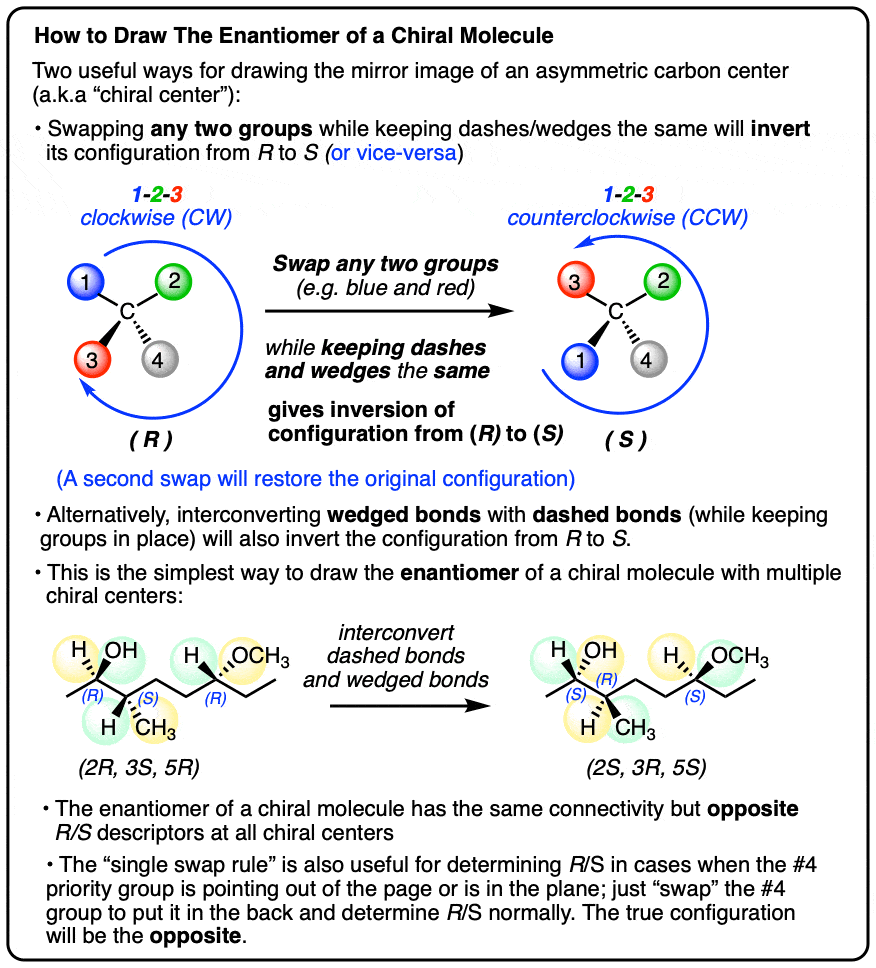
Table of Contents
- The Single Swap Rule
- Switching Any Two Groups Interconverts (R/S) (It doesn’t matter which two!)
- One Swap Gives Inversion of Configuration. Two Swaps Gives Retention
- Two Ways To Draw The Enantiomer Of A Molecule With 1 Chiral Center
- Drawing The Enantiomer Of A Molecule With 2 or More Chiral Centers
- Just Watch Out For Meso Compounds
- Applications of The Single Swap Rule – Determining R/S When #4 Group Is In The Front
- Applications of The Single Swap Rule (2) – Determining R/S When #4 Group Is In The Plane of The Page
- Drawing Diastereomers
- Flipping 3 Groups Gives A Bond Rotation
- Summary
- Notes
- Quiz Yourself!
- (Advanced) References and Further Reading
1. The Single Swap Rule
Here’s a neat trick.
- Swapping any two groups on an asymmetric (“chiral”) carbon atom transforms the configuration around carbon to its mirror image.
- For a molecule with a single chiral center, this means that doing a single swap on that chiral center will result in the enantiomer.
- A second swap of two groups will restore the original configuration.
A nice description of this principle (not my invention) is to call it the “single swap rule”
For chemistry purposes, two molecules that are superimposable will have identical chemical and physical properties and are considered to be identical molecules.
Two molecules that are non-superimposable [Note 1 ] are not identical and will have at least some differences in their physical and chemical properties (like melting points, boiling points, solubility properties, and more)
The special case where two non-superimposable molecules are also mirror images is called optical isomerism and the two molecules are referred to as enantiomers. [See article: Types of Isomers]
Enantiomers have identical physical properties except for the direction in which they rotate plane-polarized light. [See article: Optical Rotation, Optical Activity and Specific Rotation]
Optical isomerism is most commonly encountered in the case of molecules containing a carbon attached to four different groups (an asymmetric carbon center or “chiral carbon”) . [Note 2]
2. Yes, Really – Switch Any Two Groups – (It doesn’t matter which two)
If you do the math, a tetrahedral carbon with 4 different substituents will have six possible ways to swap two groups.
Are they all really equivalent?
Yes! You can verify this yourself by using a model kit. Starting with two identical molecules, swap any two groups and see what happens. You should find that you have created the enantiomer.
Alternatively…. here is a video of flipping all 6, so you don’t have to do it
3. Doing a single swap inverts R/S.
You may recall that one way to distinguish enantiomers is that they have the same connectivity but opposite (R/S) values.
For example the enantiomer of (R)-AwesomeMoleculene will naturally be (S)-AwesomeMoleculene
Since doing a single swap converts a chiral molecule with one asymmetric carbon to its enantiomer, it is also true is that doing a single swap on a chiral carbon will flip the configuration of that carbon from (R) to (S) (or from S to R).
[For more on (R) and (S) see this article on The Cahn-Ingold-Prelog Rules (CIP).] Briefly, the four atoms directly attached to the chiral carbon are assigned priorities 1-2-3-4 based on atomic weight (with rules for breaking ties, if necessary). Then with the #4 substituent in the back, we trace the path of the 1-2-3 substituents to see if they follow a clockwise (R) or counterclockwise (S) direction.]
Let’s say for the molecule in the videos above, these 4 atoms have priorities
- B = 1,
- G = 2,
- R = 3,
- W = 4
(I’ve done this based on alphabetical order, but we could assign B = bromine G = chlorine R = fluorine and W = hydrogen if we want to)
Our starting molecule has the (R) configuration. Flipping any two groups (e.g. blue and red) gives the enantiomer, which has the (S) configuration.
[Note that in this example we are only exchanging the groups and otherwise leaving the bonds alone – much like what one would do when plucking atoms off a model kit and reattaching in a different order. There’s a second way to do a single swap where the groups are left alone and the dashed/wedged bonds are swapped that we will discuss shortly]
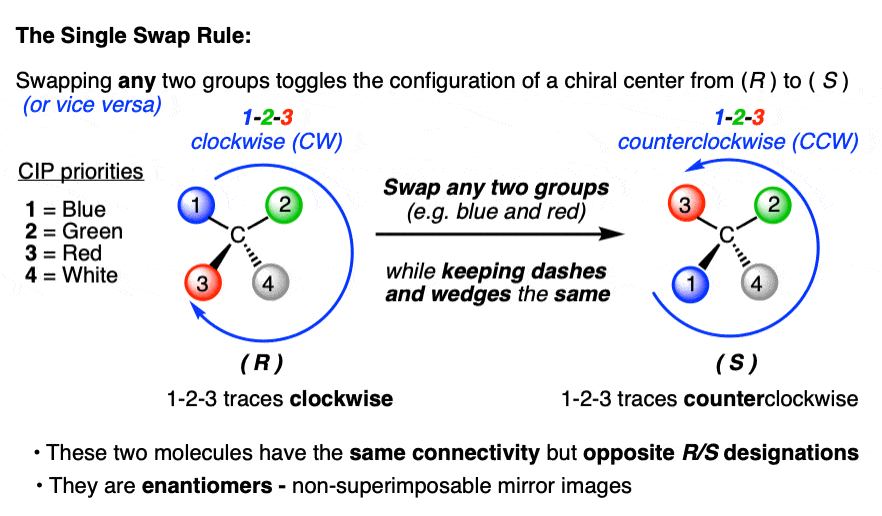
A second swap (e.g. of blue and green) gives the enantiomer of (S), which now has the (R) configuration – the configuration of our original molecule!
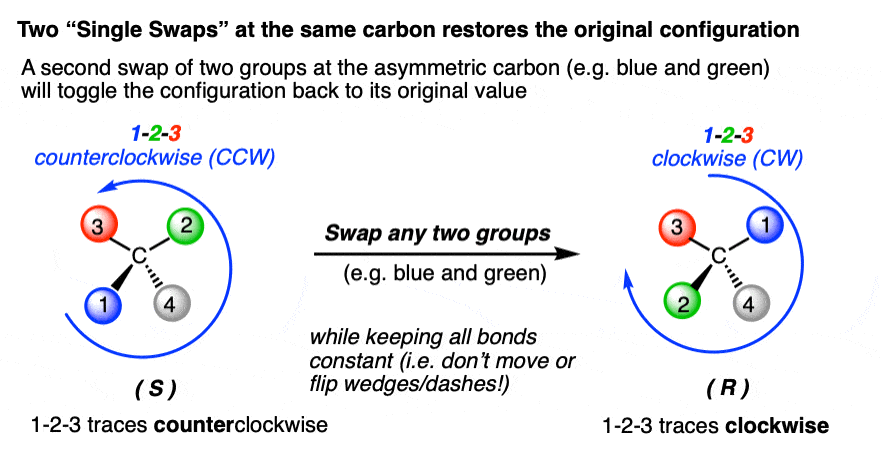
So every time we do a single swap we toggle between (S) and (R) – an inversion of configuration.
It doesn’t matter which two groups you pick, you will get the same result.
Two single swaps will lead to retention of configuration.
4. How To Draw The Enantiomer Of Any Molecule With A Single Chiral Center (Two Ways)
All right. Let’s say we have a chiral molecule with a single chiral center and we are asked to draw the enantiomer.
How would we do that?
When you just have a single chiral center and a linear molecule, it’s pretty straightforward – even if the molecule is drawn in a Newman, Fischer or sawhorse projection. Here’s how.
While keeping the bonds from the asymmetric carbon constant (i.e. don’t move the bonds, don’t convert wedges to dashes or vice-versa, etc.) all we have to do is swap the position of two groups. Just like you would when interconverting two groups on a model kit.
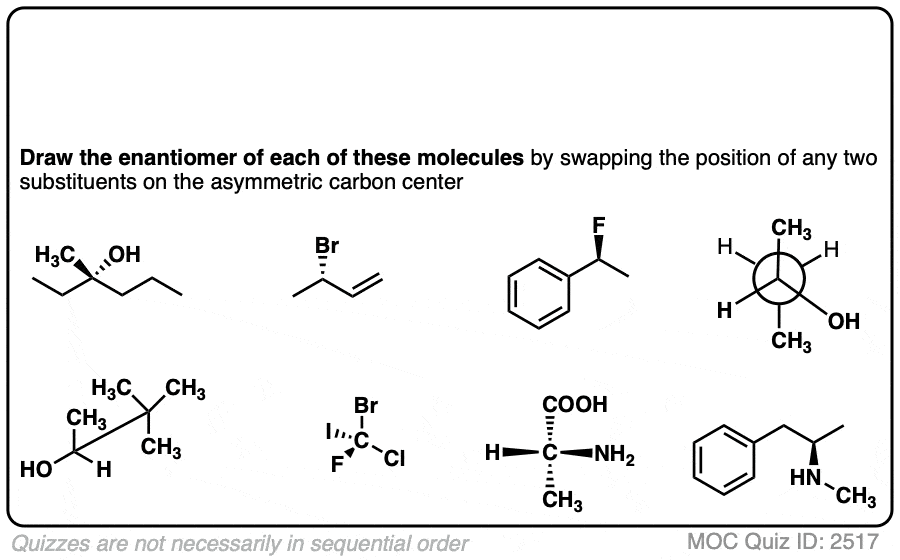 Click to Flip
Click to Flip
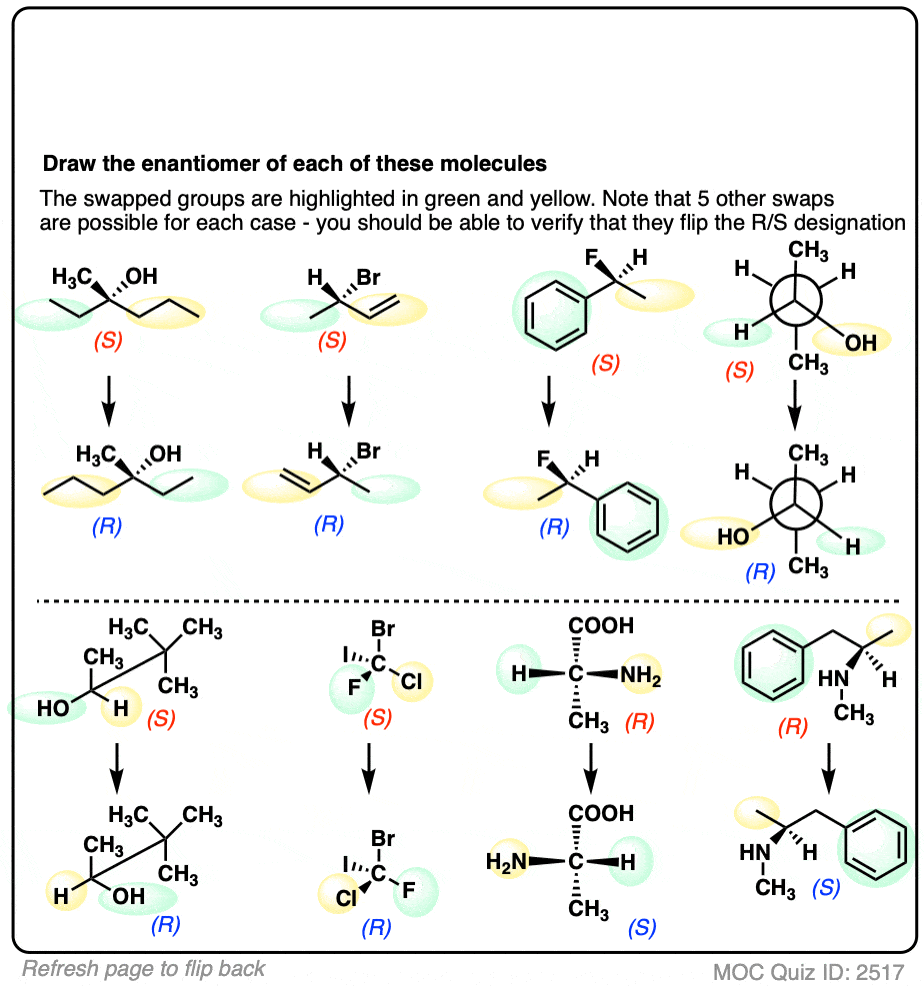
This can work pretty well. However, there are some situations where swapping the position of two groups will give ridiculous-looking results, especially when we have chiral centers that are part of a ring – hover here or click the link.
Thankfully there is a second, equivalent method of doing a single swap that works even better for most cases.
The second method of doing a single swap is to keep all groups in the same place, and then swap a wedged bond with a dashed bond.
Like this:
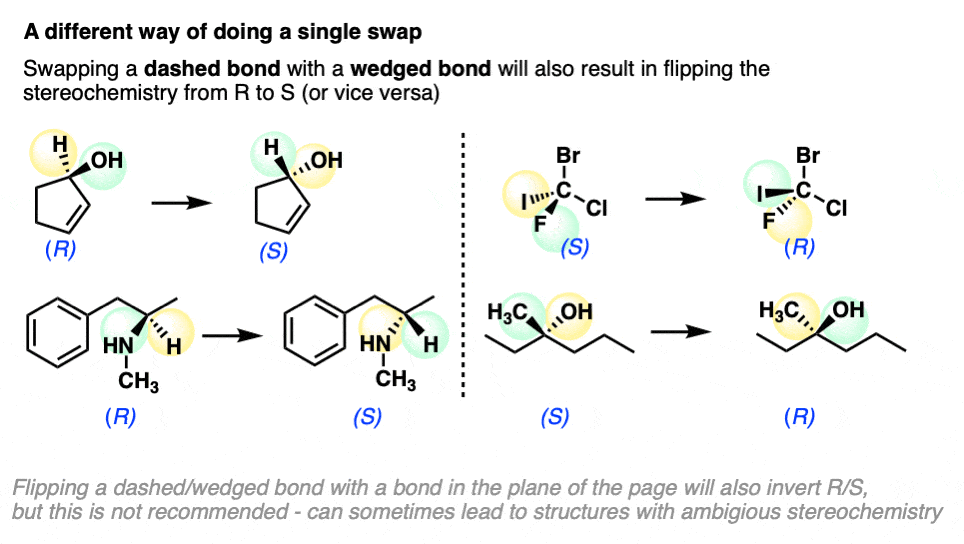
Note that we didn’t “move” the position of the atoms, we just interconverted which bond was wedged and which was dashed. But it still results in flipping (R) to (S) !
There are many times when you will encounter an asymmetric carbon atom drawn such that only one group is drawn as a dash or a wedge.
This is often the case when the chiral carbon has an implied (“hidden”) hydrogen hover here (link) or when specifying the stereochemistry of just one group is sufficient to determine (R/S) hover here (link).
In these cases, just toggle that one bond between wedge/dash and you will have performed a single swap.
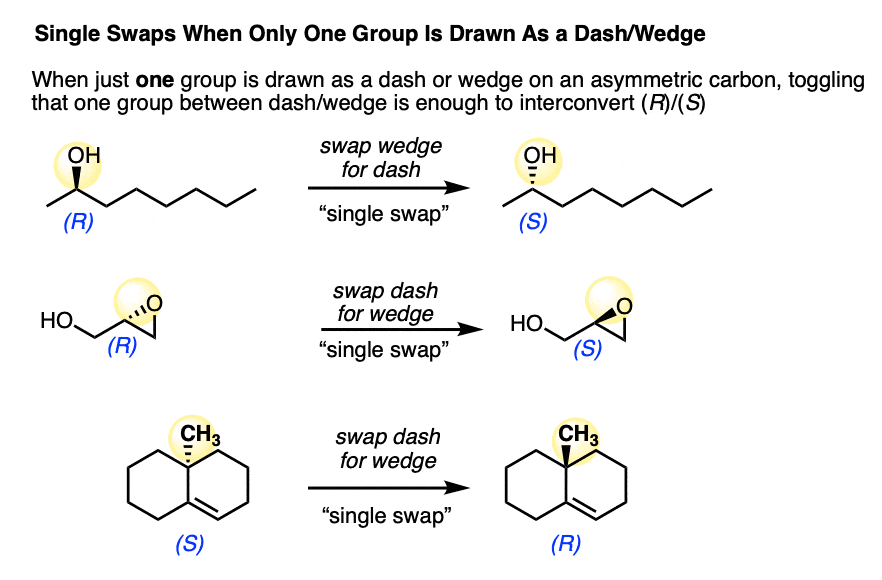
Here are some exercises on drawing enantiomers using the single swap principle:
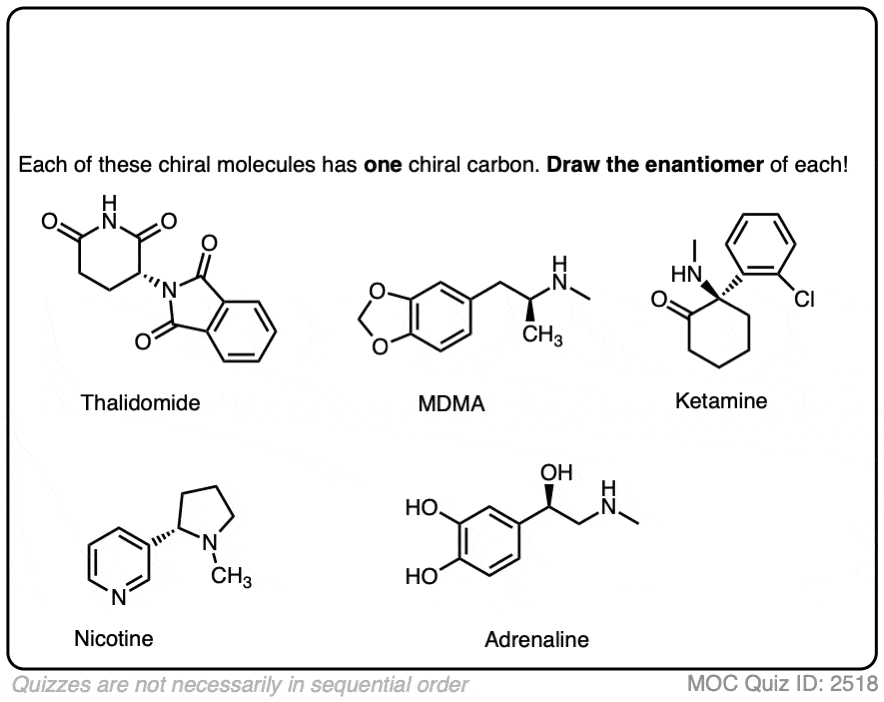 Click to Flip
Click to Flip
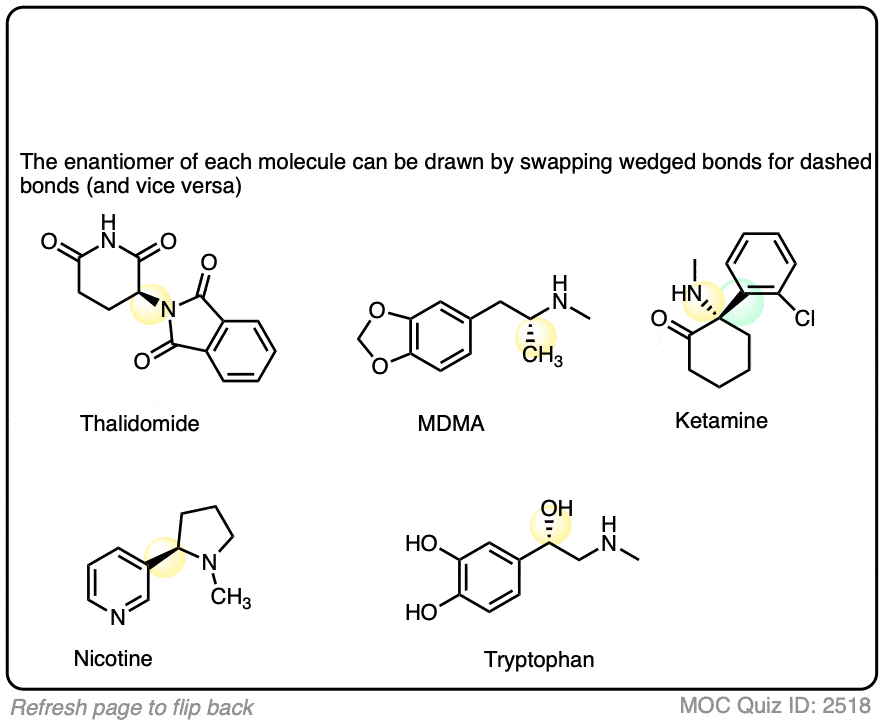
5. Drawing The Enantiomer Of Molecules With 2 Or More Chiral Centers
What if a molecule has more than one chiral center? Does this still work for drawing enantiomers? Yes! *
(* see section 6)
Here is (2R, 3R) tartaric acid. How would you draw the enantiomer?
 Click to Flip
Click to Flip
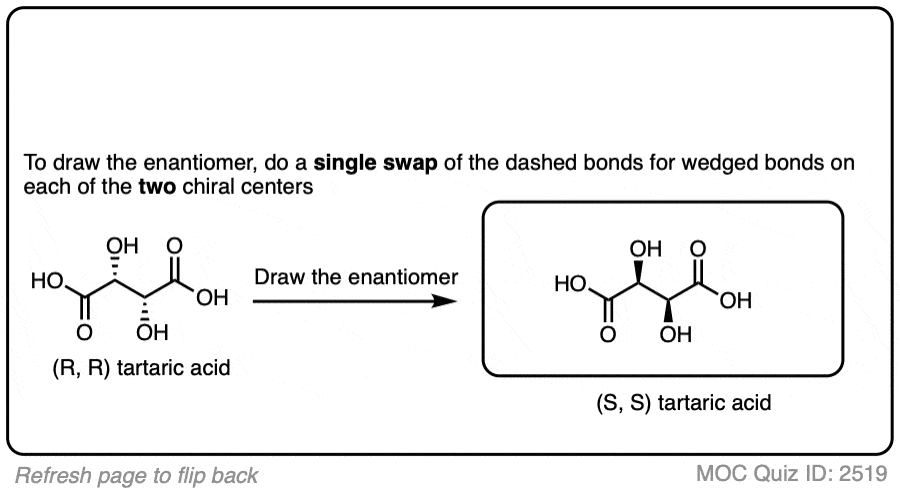
If you said, “just make all the wedges into dashes, and all the dashes into wedges”, then good job. This is sufficient to convert the molecule into its enantiomer.
Now that you’ve done that, draw the enantiomers of these molecules each with two chiral centers (some of which you may have heard of).
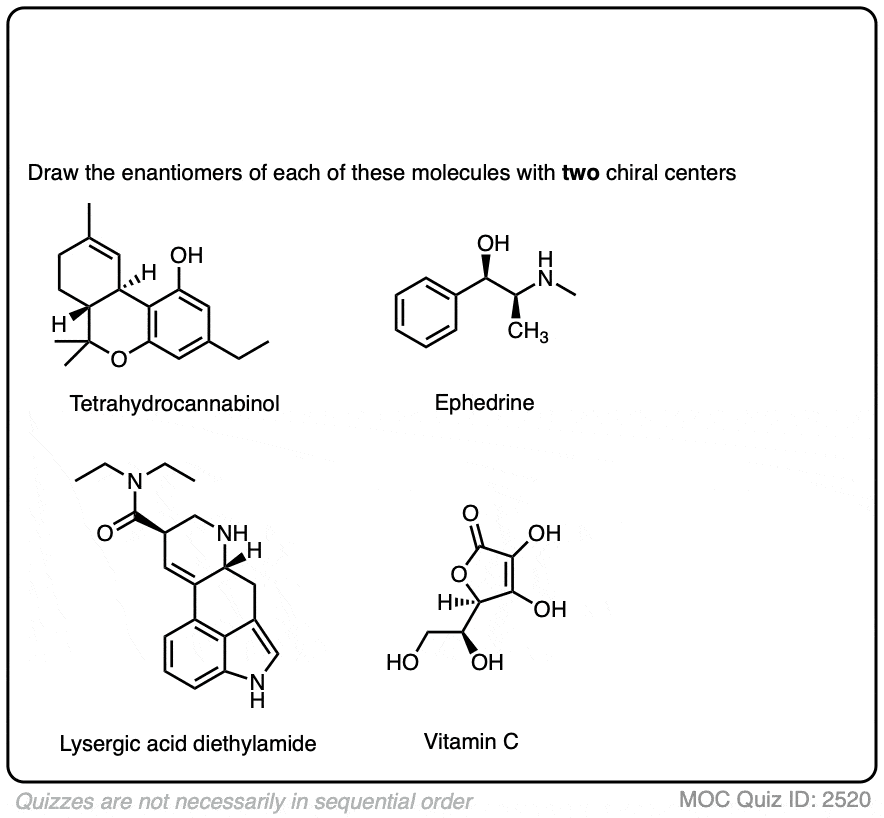 Click to Flip
Click to Flip
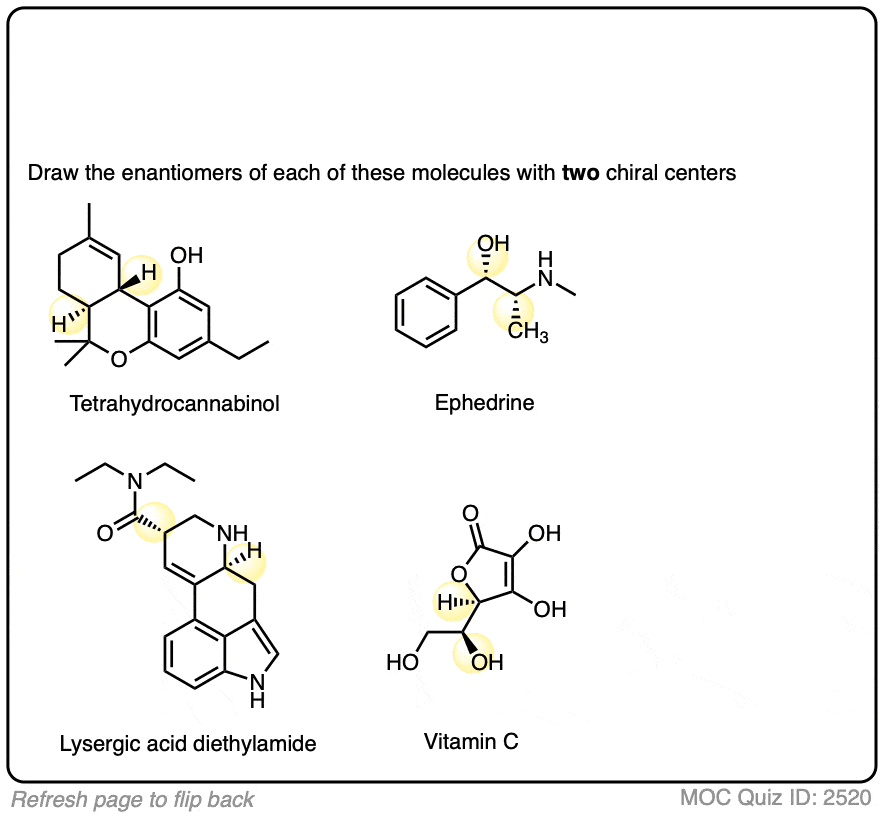
Let’s stretch it out a bit. What if our molecule has three (or even four!) chiral centers?
Still works! Just find the chiral centers and do single swaps on each:
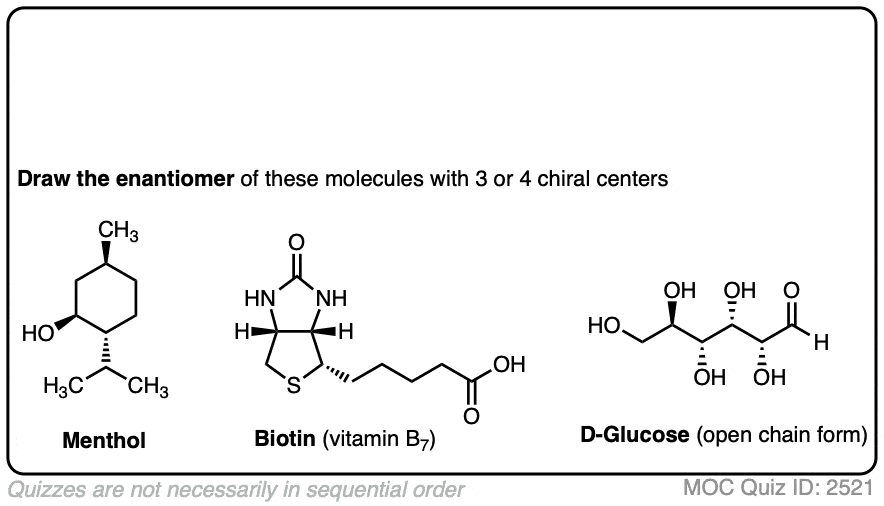 Click to Flip
Click to Flip
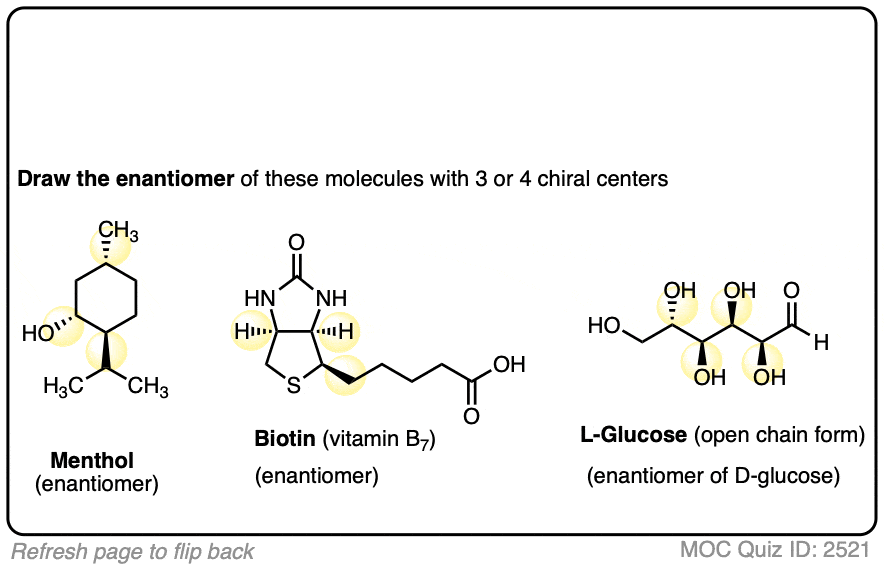
Let’s get even more ambitious. Here are two famous molecules with multiple chiral centers. See if you can draw their enantiomers.
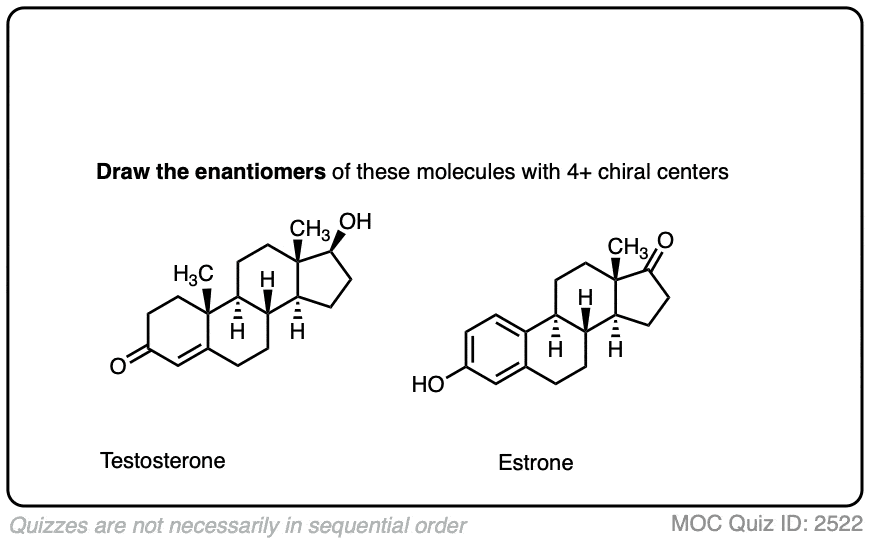 Click to Flip
Click to Flip
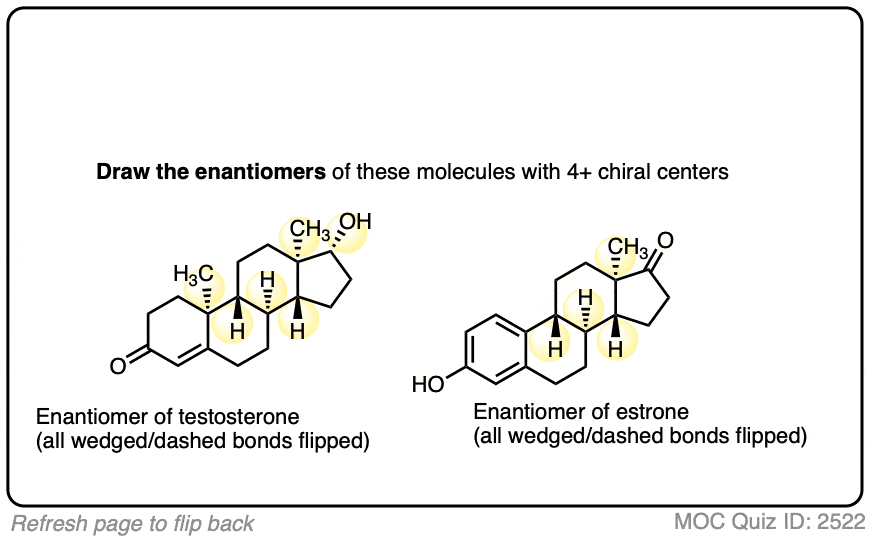
Note that once your molecule reaches a certain size, interconverting dashes and wedges becomes much more convenient than moving atoms around.
6. Just Watch Out For Meso Compounds
Now that we’re feeling confident, let’s try another fun example.
Convert (2R, 3S) tartaric acid to its mirror image by doing two single swaps.
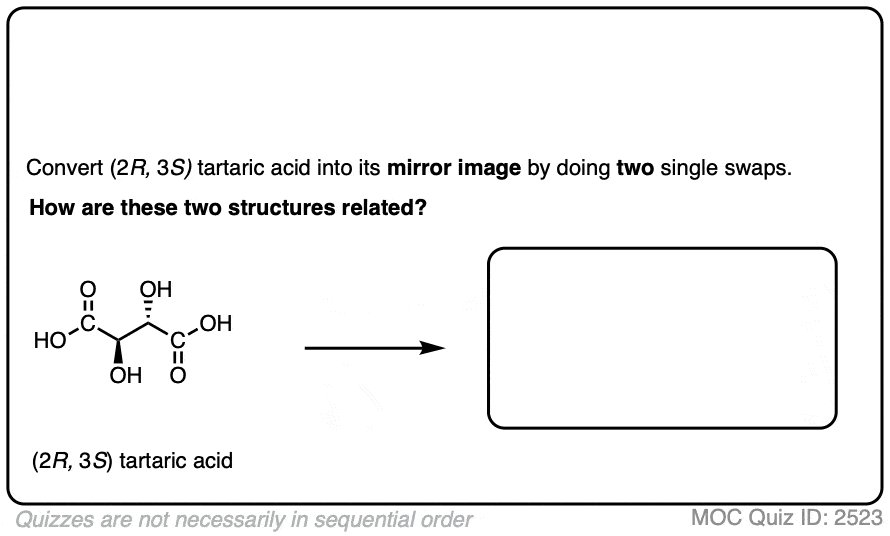 Click to Flip
Click to Flip
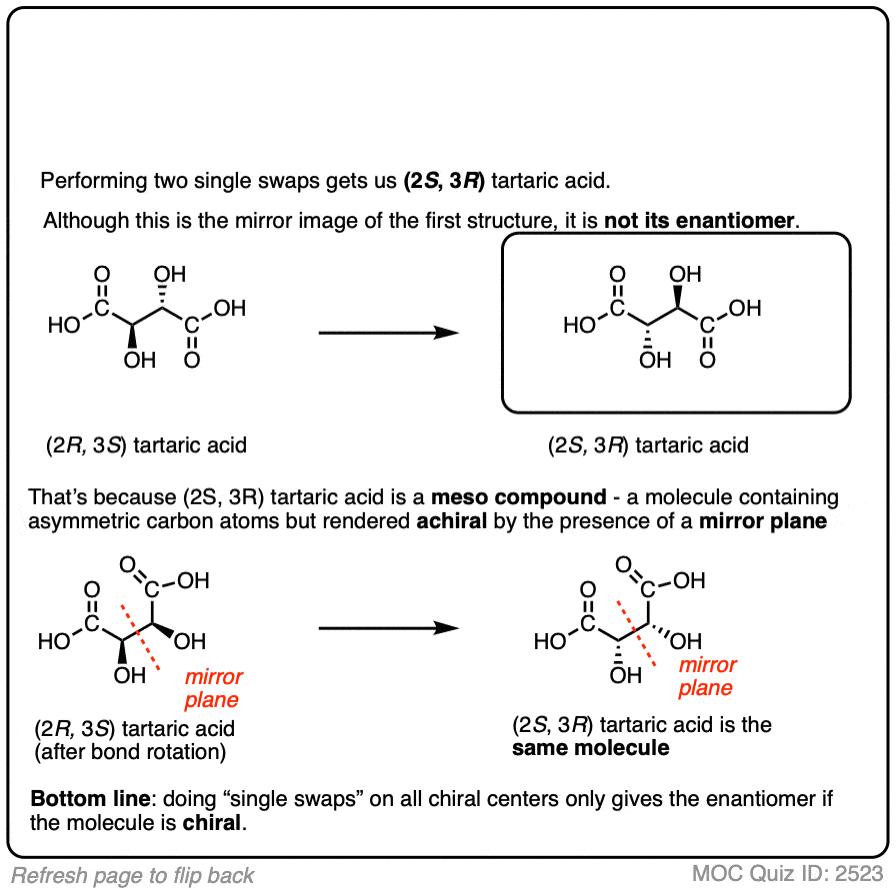
Sure enough, this gives us (2S, 3R) tartaric acid.
But is this the enantiomer? No!
Why not? Because (R,S) tartaric acid is a meso compound – a molecule with chiral centers that contains an internal mirror plane. It’s an achiral molecule. (See article – Meso Compounds)
(This is easier to see once you do a bond rotation to reveal the mirror plane.)
So the “single swap rule” has a catch. Flipping all the chiral centers will only result in the enantiomer if the compound is chiral.
If you flip all the chiral centers on a meso compound, you’ll still have an achiral compound.
7. Using the single swap rule for determining R/S when #4 is not in front.
The single swap rule is also helpful for determining R/S.
As mentioned above, R/S is determined by placing the priority #4 substituent in the back and then tracing the path of the 1-2-3 substituents.
(See article – Introduction to Assigning (R) and (S) – the Cahn Ingold Prelog Priority Rules).
The trouble is that we will often encounter situations where #4 isn’t always helpfully drawn in the back (i.e. as a “dash”).
One way to solve this is to get out your model kit, build the molecule and then rotate it around so that #4 is in the back.
You know, like in this molecule.

As one of my students once said, “when I hear my instructor say “make a model” it’s like hearing my mom say, “clean your room“.
OK, OK! You don’t need to make a model.
Single swap rule to the rescue!
Just flip the #4 priority group with the group that is a dash. When you do this, you will flip R to S (or vice versa).
Now you can determine R/S like you normally would.
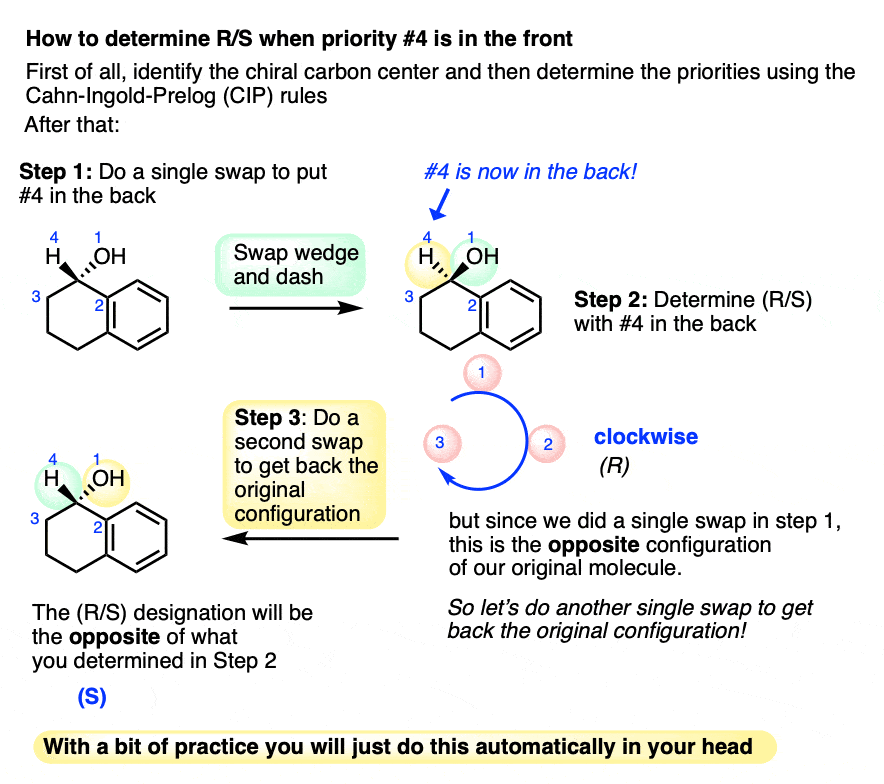
The thing is, whatever absolute configuration you get (R or S), the true configuration will be the opposite since you previously did a single swap.
Knowing this, just “flip” the value you got to the opposite, and you’ll have the true absolute configuration.
Note that although I’ve drawn this entire process out, I think you’ll find that with a little bit of practice, you’ll just end up doing this in your head when you see that the hydrogen (or whatever other #4 priority group you encounter) is pointing out of the page.
It’s a very useful trick.
8. Using The Single Swap Rule When #4 Is In The Plane of the Page
This trick also works when the #4 group is in the plane of the page.
As before, just do a single swap to put the group in the back. Then determine R/S.
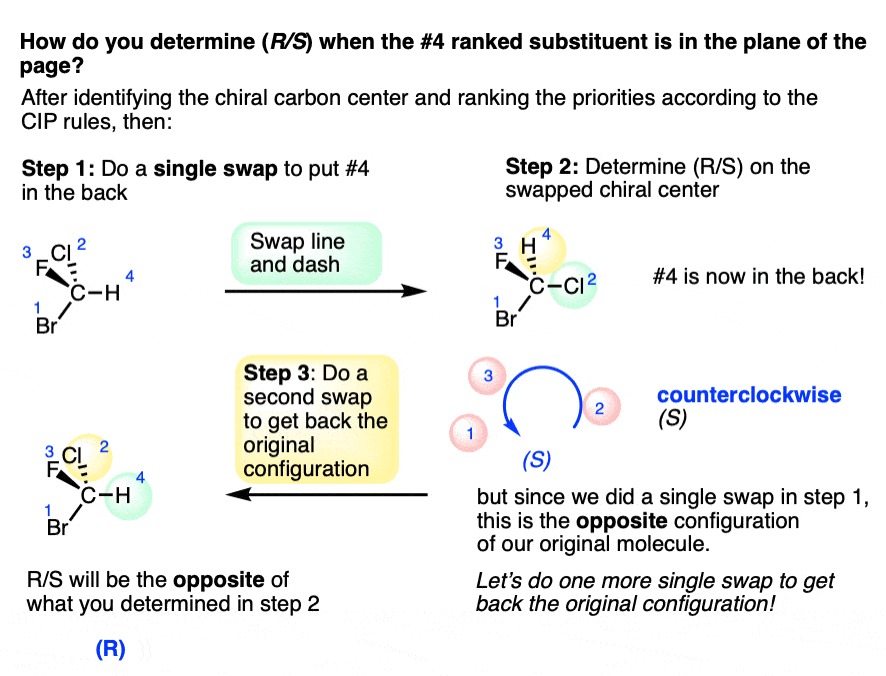
Whatever value of R/S you obtain will the the opposite of the “true” absolute configuration. So toggle the R/S value to get the true absolute configuration.
9. Drawing Diastereomers
The single swap rule is also useful for drawing diastereomers.
Recall that diastereomers are stereoisomers that aren’t enantiomers. (See article – Types of Isomers)
Since not all chiral centers have to have opposite values from each other, finding a diastereomer of a given molecule isn’t too difficult.
For example, a molecule with 5 chiral centers will have 25 possible stereoisomers (32).
Testosterone (below) represents one of those 32 possibilities. Its enantiomer is another.
The other 30 possibilities are all diastereomers of testosterone.
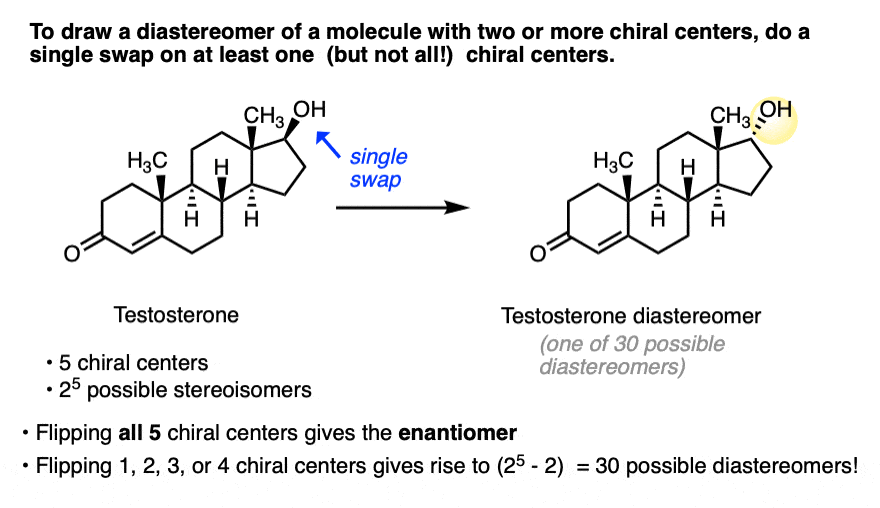
So to draw a diastereomer of a molecule you just need to draw a stereoisomer that isn’t an enantiomer.
- That means that for a molecule with N chiral centers, do at least 1 but less than N single swaps.
- Alternatively, flip a double bond from (E) to (Z)
10. Flipping 3 is a bond rotation
When doing a single swap, make sure you stop at interconverting just two groups.
Why?
In the example below, three groups have been interchanged. What happens to the absolute configuration (R/S) ?
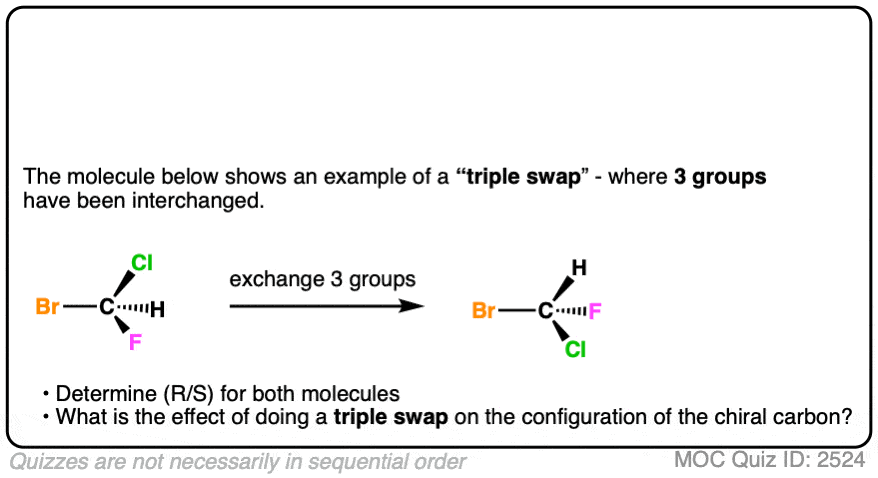 Click to Flip
Click to Flip
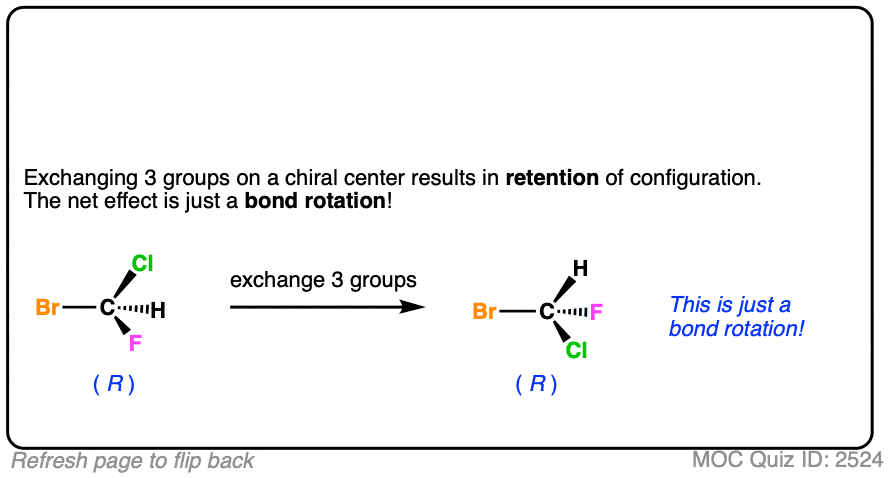
That’s right. Interchanging 3 groups results in a bond rotation. I’ll have more to say about that in a future post.
11. Summary
- Swapping any two groups on an asymmetric carbon will flip its configuration from (R) to (S) or vice versa
- A second swap will result in retention of configuration
- For a chiral molecule with a single chiral center, this means that performing a single swap will result in its enantiomer.
- An alternative way to perform a single swap is to interchange a wedged and dashed bond on a chiral carbon.
- To draw the enantiomer of a molecule with two or more chiral centers, swap dashed/wedged bonds on all chiral carbons. Just watch out for meso compounds (which are achiral and don’t have an enantiomer).
- To determine (R/S) on a molecule where the #4 priority substituent is in the front (or in the plane of the page!) , perform a single swap to put the #4 group in the back. Then determine (R/S). The true absolute configuration will be the opposite of this value.
- Interchanging 3 groups results in a bond rotation (with retention of absolute configuration!)
Notes
Note 1 – Determining whether two molecules are superimposable also implies a certain time frame. For example, it’s possible for a molecule to have two conformations which are non-superimposable mirror images of each other. However, if these two conformers interconvert on a fast-enough time frame, then any effects of these enantiomeric conformers – such as equal and opposite optical rotation – will be cancelled out.
One fairly arbitrary (but practical!) test is, “Can you store the two enantiomers in separate bottles without them interconverting”. Certain conformers with hindered rotation – known as atropisomers – fit this description. One can purchase the enantiomers of 2-binaphthol.
Note 2 – Other forms of chirality exist besides the situation where there are four different groups on tetrahedral carbon. Another prominent example often encountered in undergraduate organic chemistry is molecules that include an axis of chirality, such as certain substituted allenes. [See article – Chiral Allenes and Chiral Axes]
Quiz Yourself!
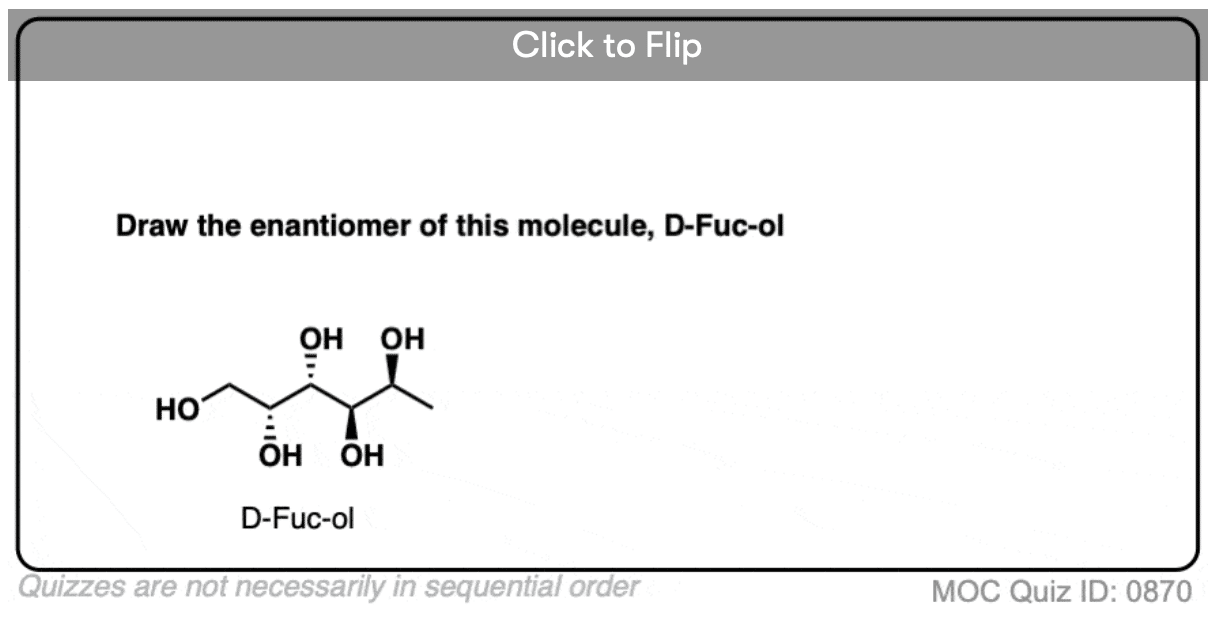
Become a MOC member to see the clickable quiz with answers on the back.
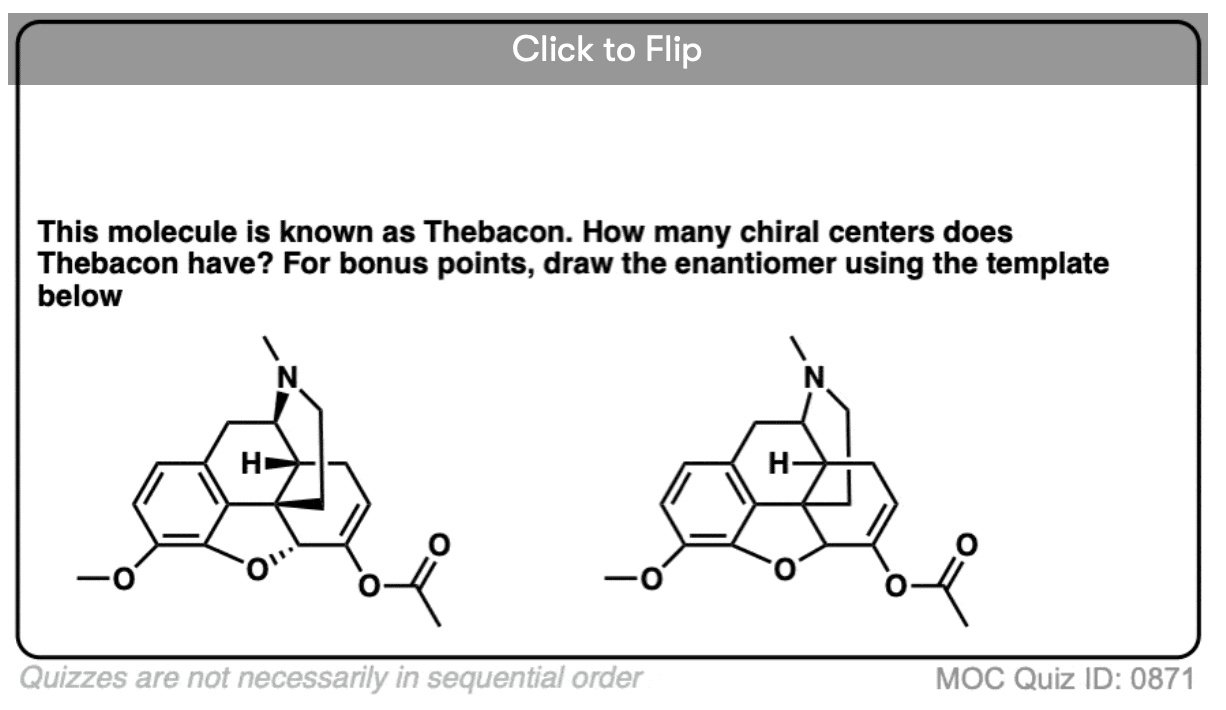
Become a MOC member to see the clickable quiz with answers on the back.
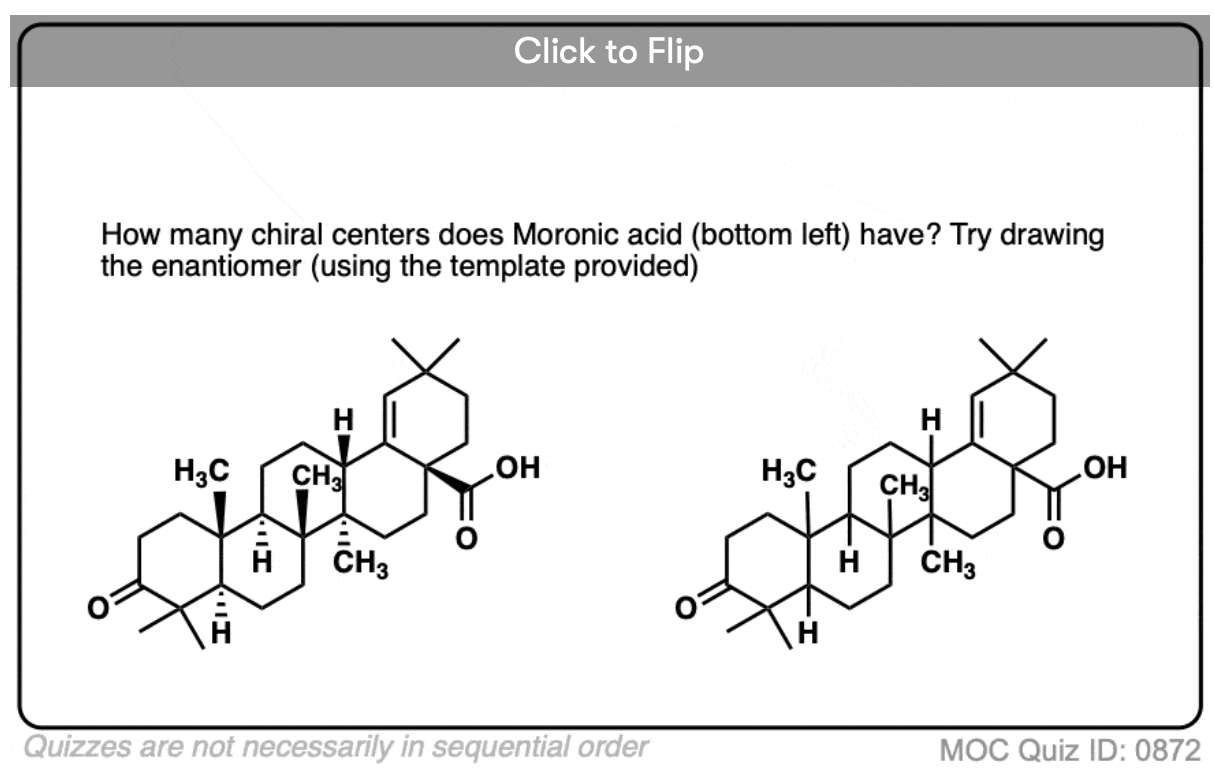
Become a MOC member to see the clickable quiz with answers on the back.
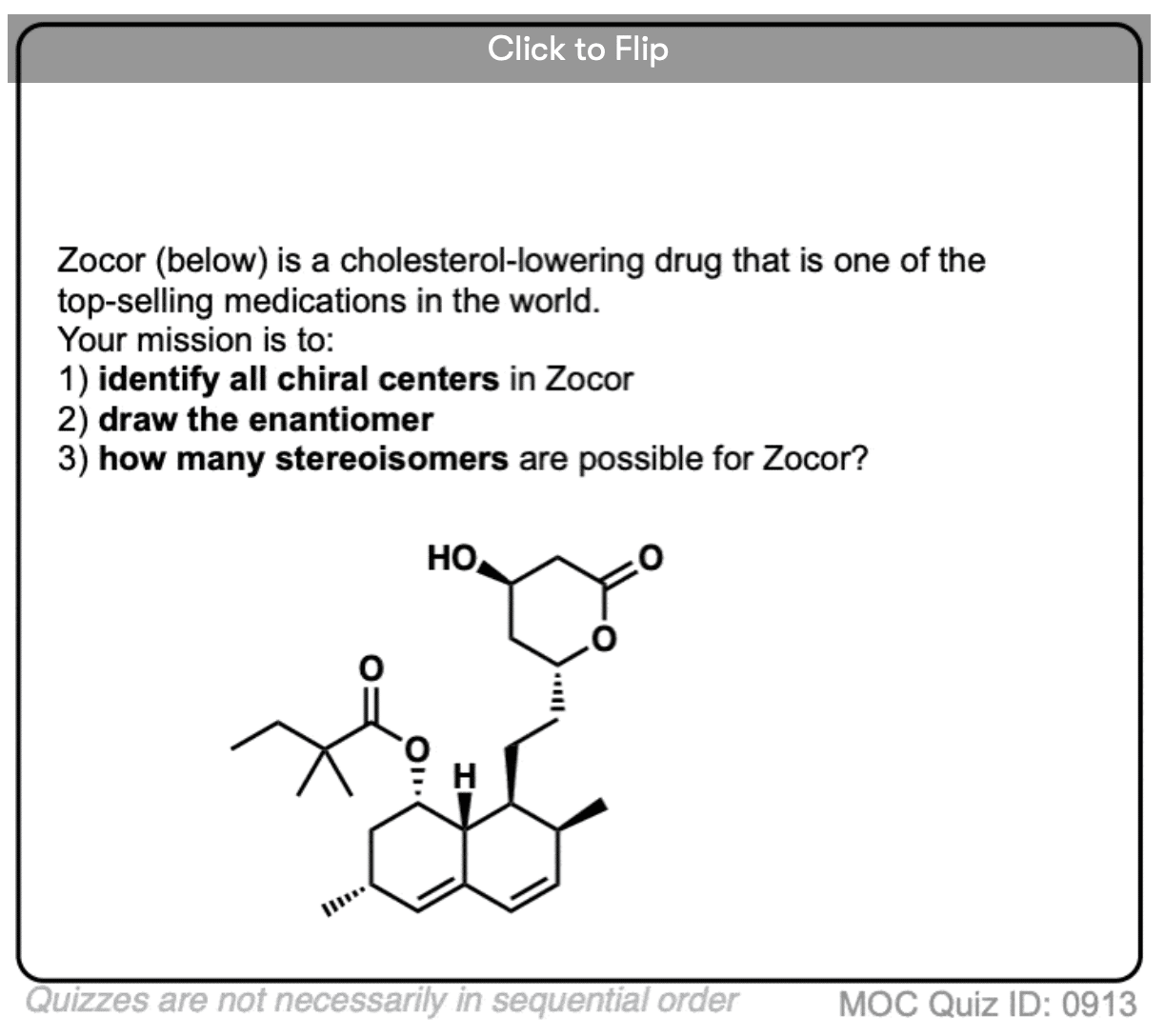
Become a MOC member to see the clickable quiz with answers on the back.
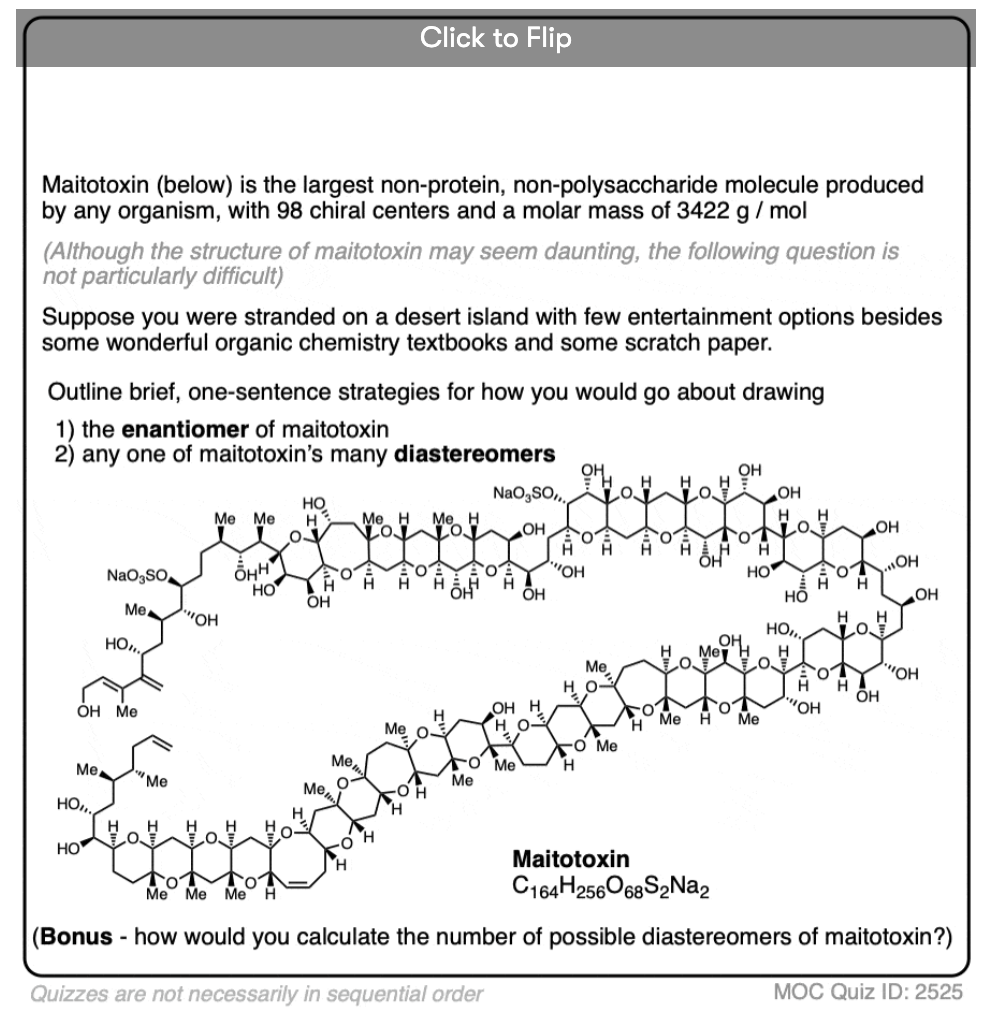
Become a MOC member to see the clickable quiz with answers on the back.
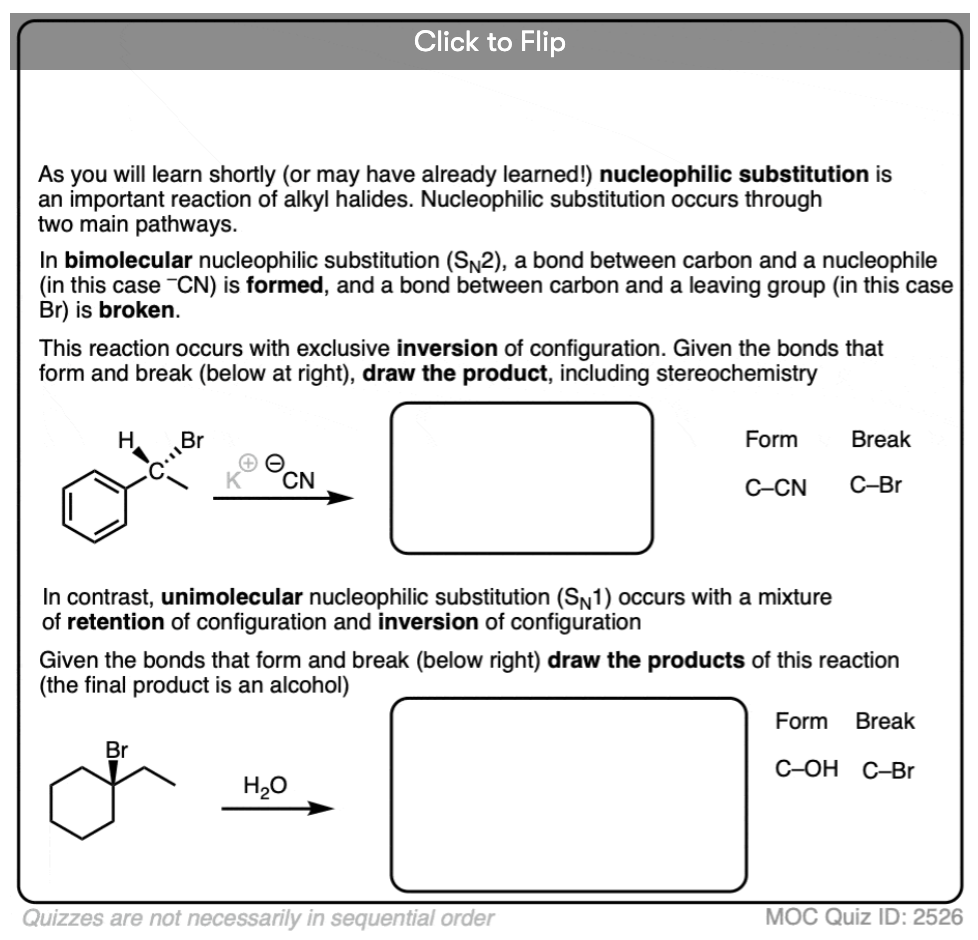
Become a MOC member to see the clickable quiz with answers on the back.
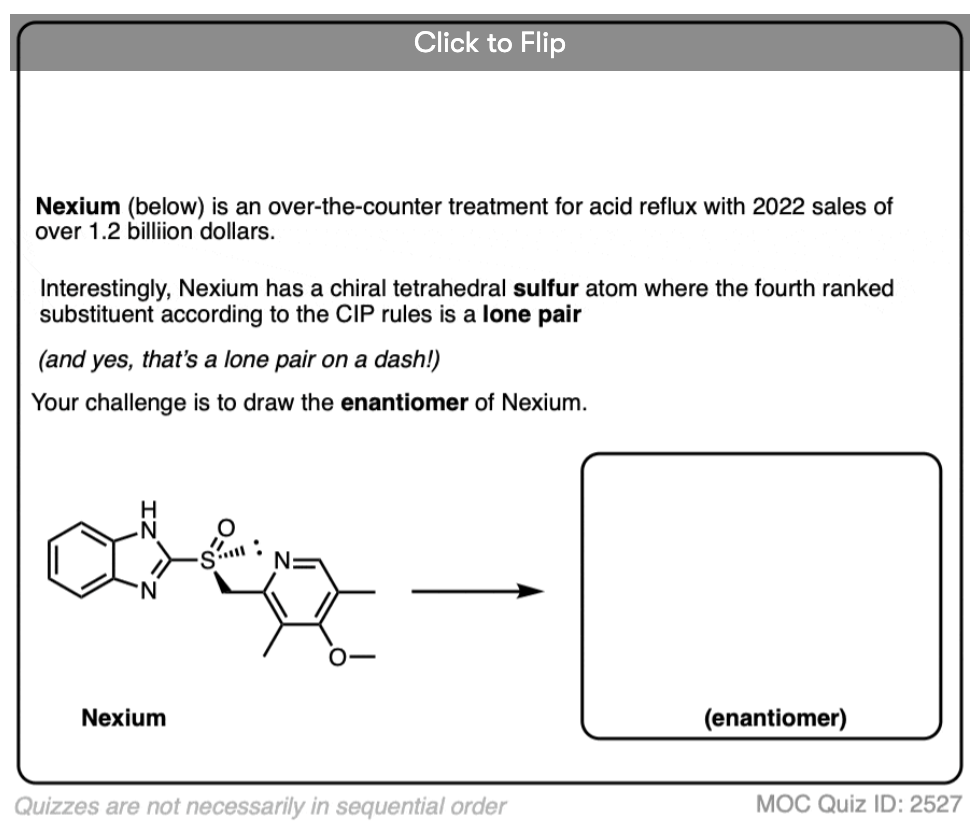
Become a MOC member to see the clickable quiz with answers on the back.
(Advanced) References and Further Reading
[References]
00 General Chemistry Review
01 Bonding, Structure, and Resonance
- How Do We Know Methane (CH4) Is Tetrahedral?
- Hybrid Orbitals and Hybridization
- How To Determine Hybridization: A Shortcut
- Orbital Hybridization And Bond Strengths
- Sigma bonds come in six varieties: Pi bonds come in one
- Dipole Moments and Dipoles
- A Key Skill: How to Calculate Formal Charge
- The Four Intermolecular Forces and How They Affect Boiling Points
- 3 Trends That Affect Boiling Points
- How To Use Electronegativity To Determine Electron Density (and why NOT to trust formal charge)
- Introduction to Resonance
- How To Use Curved Arrows To Interchange Resonance Forms
- Evaluating Resonance Forms (1) - The Rule of Least Charges
- How To Find The Best Resonance Structure By Applying Electronegativity
- Evaluating Resonance Structures With Negative Charges
- Evaluating Resonance Structures With Positive Charge
- Exploring Resonance: Pi-Donation
- Exploring Resonance: Pi-acceptors
- In Summary: Evaluating Resonance Structures
- Drawing Resonance Structures: 3 Common Mistakes To Avoid
- How to apply electronegativity and resonance to understand reactivity
- Bond Hybridization Practice
- Structure and Bonding Practice Quizzes
- Resonance Structures Practice
02 Acid Base Reactions
- Introduction to Acid-Base Reactions
- Acid Base Reactions In Organic Chemistry
- The Stronger The Acid, The Weaker The Conjugate Base
- Walkthrough of Acid-Base Reactions (3) - Acidity Trends
- Five Key Factors That Influence Acidity
- Acid-Base Reactions: Introducing Ka and pKa
- How to Use a pKa Table
- The pKa Table Is Your Friend
- A Handy Rule of Thumb for Acid-Base Reactions
- Acid Base Reactions Are Fast
- pKa Values Span 60 Orders Of Magnitude
- How Protonation and Deprotonation Affect Reactivity
- Acid Base Practice Problems
03 Alkanes and Nomenclature
- Meet the (Most Important) Functional Groups
- Condensed Formulas: Deciphering What the Brackets Mean
- Hidden Hydrogens, Hidden Lone Pairs, Hidden Counterions
- Don't Be Futyl, Learn The Butyls
- Primary, Secondary, Tertiary, Quaternary In Organic Chemistry
- Branching, and Its Affect On Melting and Boiling Points
- The Many, Many Ways of Drawing Butane
- Wedge And Dash Convention For Tetrahedral Carbon
- Common Mistakes in Organic Chemistry: Pentavalent Carbon
- Table of Functional Group Priorities for Nomenclature
- Summary Sheet - Alkane Nomenclature
- Organic Chemistry IUPAC Nomenclature Demystified With A Simple Puzzle Piece Approach
- Boiling Point Quizzes
- Organic Chemistry Nomenclature Quizzes
04 Conformations and Cycloalkanes
- Staggered vs Eclipsed Conformations of Ethane
- Conformational Isomers of Propane
- Newman Projection of Butane (and Gauche Conformation)
- Introduction to Cycloalkanes
- Geometric Isomers In Small Rings: Cis And Trans Cycloalkanes
- Calculation of Ring Strain In Cycloalkanes
- Cycloalkanes - Ring Strain In Cyclopropane And Cyclobutane
- Cyclohexane Conformations
- Cyclohexane Chair Conformation: An Aerial Tour
- How To Draw The Cyclohexane Chair Conformation
- The Cyclohexane Chair Flip
- The Cyclohexane Chair Flip - Energy Diagram
- Substituted Cyclohexanes - Axial vs Equatorial
- Ranking The Bulkiness Of Substituents On Cyclohexanes: "A-Values"
- Cyclohexane Chair Conformation Stability: Which One Is Lower Energy?
- Fused Rings - Cis-Decalin and Trans-Decalin
- Naming Bicyclic Compounds - Fused, Bridged, and Spiro
- Bredt's Rule (And Summary of Cycloalkanes)
- Newman Projection Practice
- Cycloalkanes Practice Problems
05 A Primer On Organic Reactions
- The Most Important Question To Ask When Learning a New Reaction
- Curved Arrows (for reactions)
- Nucleophiles and Electrophiles
- The Three Classes of Nucleophiles
- Nucleophilicity vs. Basicity
- What Makes A Good Nucleophile?
- What Makes A Good Leaving Group?
- 3 Factors That Stabilize Carbocations
- Equilibrium and Energy Relationships
- 7 Factors that stabilize negative charge in organic chemistry
- 7 Factors That Stabilize Positive Charge in Organic Chemistry
- What's a Transition State?
- Hammond's Postulate
- Learning Organic Chemistry Reactions: A Checklist (PDF)
06 Free Radical Reactions
- Free Radical Reactions
- 3 Factors That Stabilize Free Radicals
- Bond Strengths And Radical Stability
- Free Radical Initiation: Why Is "Light" Or "Heat" Required?
- Initiation, Propagation, Termination
- Monochlorination Products Of Propane, Pentane, And Other Alkanes
- Selectivity In Free Radical Reactions
- Selectivity in Free Radical Reactions: Bromination vs. Chlorination
- Halogenation At Tiffany's
- Allylic Bromination
- Bonus Topic: Allylic Rearrangements
- In Summary: Free Radicals
- Synthesis (2) - Reactions of Alkanes
- Free Radicals Practice Quizzes
07 Stereochemistry and Chirality
- Types of Isomers: Constitutional Isomers, Stereoisomers, Enantiomers, and Diastereomers
- How To Draw The Enantiomer Of A Chiral Molecule
- How To Draw A Bond Rotation
- Introduction to Assigning (R) and (S): The Cahn-Ingold-Prelog Rules
- Assigning Cahn-Ingold-Prelog (CIP) Priorities (2) - The Method of Dots
- Enantiomers vs Diastereomers vs The Same? Two Methods For Solving Problems
- Assigning R/S To Newman Projections (And Converting Newman To Line Diagrams)
- How To Determine R and S Configurations On A Fischer Projection
- The Meso Trap
- Optical Rotation, Optical Activity, and Specific Rotation
- Optical Purity and Enantiomeric Excess
- What's a Racemic Mixture?
- Chiral Allenes And Chiral Axes
- Stereochemistry Practice Problems and Quizzes
08 Substitution Reactions
- Nucleophilic Substitution Reactions - Introduction
- Two Types of Nucleophilic Substitution Reactions
- The SN2 Mechanism
- Why the SN2 Reaction Is Powerful
- The SN1 Mechanism
- The Conjugate Acid Is A Better Leaving Group
- Comparing the SN1 and SN2 Reactions
- Polar Protic? Polar Aprotic? Nonpolar? All About Solvents
- Steric Hindrance is Like a Fat Goalie
- Common Blind Spot: Intramolecular Reactions
- Substitution Practice - SN1
- Substitution Practice - SN2
09 Elimination Reactions
- Elimination Reactions (1): Introduction And The Key Pattern
- Elimination Reactions (2): The Zaitsev Rule
- Elimination Reactions Are Favored By Heat
- Two Elimination Reaction Patterns
- The E1 Reaction
- The E2 Mechanism
- E1 vs E2: Comparing the E1 and E2 Reactions
- Antiperiplanar Relationships: The E2 Reaction and Cyclohexane Rings
- Bulky Bases in Elimination Reactions
- Comparing the E1 vs SN1 Reactions
- Elimination (E1) Reactions With Rearrangements
- E1cB - Elimination (Unimolecular) Conjugate Base
- Elimination (E1) Practice Problems And Solutions
- Elimination (E2) Practice Problems and Solutions
10 Rearrangements
11 SN1/SN2/E1/E2 Decision
- Identifying Where Substitution and Elimination Reactions Happen
- Deciding SN1/SN2/E1/E2 (1) - The Substrate
- Deciding SN1/SN2/E1/E2 (2) - The Nucleophile/Base
- SN1 vs E1 and SN2 vs E2 : The Temperature
- Deciding SN1/SN2/E1/E2 - The Solvent
- Wrapup: The Key Factors For Determining SN1/SN2/E1/E2
- Alkyl Halide Reaction Map And Summary
- SN1 SN2 E1 E2 Practice Problems
12 Alkene Reactions
- E and Z Notation For Alkenes (+ Cis/Trans)
- Alkene Stability
- Alkene Addition Reactions: "Regioselectivity" and "Stereoselectivity" (Syn/Anti)
- Stereoselective and Stereospecific Reactions
- Hydrohalogenation of Alkenes and Markovnikov's Rule
- Hydration of Alkenes With Aqueous Acid
- Rearrangements in Alkene Addition Reactions
- Halogenation of Alkenes and Halohydrin Formation
- Oxymercuration Demercuration of Alkenes
- Hydroboration Oxidation of Alkenes
- m-CPBA (meta-chloroperoxybenzoic acid)
- OsO4 (Osmium Tetroxide) for Dihydroxylation of Alkenes
- Palladium on Carbon (Pd/C) for Catalytic Hydrogenation of Alkenes
- Cyclopropanation of Alkenes
- A Fourth Alkene Addition Pattern - Free Radical Addition
- Alkene Reactions: Ozonolysis
- Oxidative Cleavage of Vicinal Diols With NaIO4 and Pb(OAc)4
- Summary: Three Key Families Of Alkene Reaction Mechanisms
- Synthesis (4) - Alkene Reaction Map, Including Alkyl Halide Reactions
- Alkene Reactions Practice Problems
13 Alkyne Reactions
- Acetylides from Alkynes, And Substitution Reactions of Acetylides
- Partial Reduction of Alkynes With Lindlar's Catalyst
- Partial Reduction of Alkynes With Na/NH3 To Obtain Trans Alkenes
- Alkyne Hydroboration With "R2BH"
- Hydration and Oxymercuration of Alkynes
- Hydrohalogenation of Alkynes
- Alkyne Halogenation: Bromination and Chlorination of Alkynes
- Oxidation of Alkynes With O3 and KMnO4
- Alkenes To Alkynes Via Halogenation And Elimination Reactions
- Alkynes Are A Blank Canvas
- Synthesis (5) - Reactions of Alkynes
- Alkyne Reactions Practice Problems With Answers
14 Alcohols, Epoxides and Ethers
- Alcohols - Nomenclature and Properties
- Alcohols Can Act As Acids Or Bases (And Why It Matters)
- Alcohols - Acidity and Basicity
- The Williamson Ether Synthesis
- Ethers From Alkenes, Tertiary Alkyl Halides and Alkoxymercuration
- Alcohols To Ethers via Acid Catalysis
- Cleavage Of Ethers With Acid
- Epoxides - The Outlier Of The Ether Family
- Opening of Epoxides With Acid
- Epoxide Ring Opening With Base
- Making Alkyl Halides From Alcohols
- Tosylates And Mesylates
- PBr3 and SOCl2
- Elimination Reactions of Alcohols
- Elimination of Alcohols To Alkenes With POCl3
- Alcohol Oxidation: "Strong" and "Weak" Oxidants
- Demystifying The Mechanisms of Alcohol Oxidations
- Protecting Groups For Alcohols
- Thiols And Thioethers
- Calculating the oxidation state of a carbon
- Oxidation and Reduction in Organic Chemistry
- Oxidation Ladders
- SOCl2 Mechanism For Alcohols To Alkyl Halides: SN2 versus SNi
- Alcohol Reactions Roadmap (PDF)
- Alcohol Reaction Practice Problems
- Epoxide Reaction Quizzes
- Oxidation and Reduction Practice Quizzes
15 Organometallics
- What's An Organometallic?
- Formation of Grignard and Organolithium Reagents
- Organometallics Are Strong Bases
- Reactions of Grignard Reagents
- Protecting Groups In Grignard Reactions
- Synthesis Problems Involving Grignard Reagents
- Grignard Reactions And Synthesis (2)
- Organocuprates (Gilman Reagents): How They're Made
- Gilman Reagents (Organocuprates): What They're Used For
- The Heck, Suzuki, and Olefin Metathesis Reactions (And Why They Don't Belong In Most Introductory Organic Chemistry Courses)
- Reaction Map: Reactions of Organometallics
- Grignard Practice Problems
16 Spectroscopy
- Degrees of Unsaturation (or IHD, Index of Hydrogen Deficiency)
- Conjugation And Color (+ How Bleach Works)
- Introduction To UV-Vis Spectroscopy
- UV-Vis Spectroscopy: Absorbance of Carbonyls
- UV-Vis Spectroscopy: Practice Questions
- Bond Vibrations, Infrared Spectroscopy, and the "Ball and Spring" Model
- Infrared (IR) Spectroscopy: A Quick Primer On Interpreting Spectra
- IR Spectroscopy: 4 Practice Problems
- 1H NMR: How Many Signals?
- Homotopic, Enantiotopic, Diastereotopic
- Diastereotopic Protons in 1H NMR Spectroscopy: Examples
- 13-C NMR - How Many Signals
- Liquid Gold: Pheromones In Doe Urine
- Natural Product Isolation (1) - Extraction
- Natural Product Isolation (2) - Purification Techniques, An Overview
- Structure Determination Case Study: Deer Tarsal Gland Pheromone
17 Dienes and MO Theory
- What To Expect In Organic Chemistry 2
- Are these molecules conjugated?
- Conjugation And Resonance In Organic Chemistry
- Bonding And Antibonding Pi Orbitals
- Molecular Orbitals of The Allyl Cation, Allyl Radical, and Allyl Anion
- Pi Molecular Orbitals of Butadiene
- Reactions of Dienes: 1,2 and 1,4 Addition
- Thermodynamic and Kinetic Products
- More On 1,2 and 1,4 Additions To Dienes
- s-cis and s-trans
- The Diels-Alder Reaction
- Cyclic Dienes and Dienophiles in the Diels-Alder Reaction
- Stereochemistry of the Diels-Alder Reaction
- Exo vs Endo Products In The Diels Alder: How To Tell Them Apart
- HOMO and LUMO In the Diels Alder Reaction
- Why Are Endo vs Exo Products Favored in the Diels-Alder Reaction?
- Diels-Alder Reaction: Kinetic and Thermodynamic Control
- The Retro Diels-Alder Reaction
- The Intramolecular Diels Alder Reaction
- Regiochemistry In The Diels-Alder Reaction
- The Cope and Claisen Rearrangements
- Electrocyclic Reactions
- Electrocyclic Ring Opening And Closure (2) - Six (or Eight) Pi Electrons
- Diels Alder Practice Problems
- Molecular Orbital Theory Practice
18 Aromaticity
- Introduction To Aromaticity
- Rules For Aromaticity
- Huckel's Rule: What Does 4n+2 Mean?
- Aromatic, Non-Aromatic, or Antiaromatic? Some Practice Problems
- Antiaromatic Compounds and Antiaromaticity
- The Pi Molecular Orbitals of Benzene
- The Pi Molecular Orbitals of Cyclobutadiene
- Frost Circles
- Aromaticity Practice Quizzes
19 Reactions of Aromatic Molecules
- Electrophilic Aromatic Substitution: Introduction
- Activating and Deactivating Groups In Electrophilic Aromatic Substitution
- Electrophilic Aromatic Substitution - The Mechanism
- Ortho-, Para- and Meta- Directors in Electrophilic Aromatic Substitution
- Understanding Ortho, Para, and Meta Directors
- Why are halogens ortho- para- directors?
- Disubstituted Benzenes: The Strongest Electron-Donor "Wins"
- Electrophilic Aromatic Substitutions (1) - Halogenation of Benzene
- Electrophilic Aromatic Substitutions (2) - Nitration and Sulfonation
- EAS Reactions (3) - Friedel-Crafts Acylation and Friedel-Crafts Alkylation
- Intramolecular Friedel-Crafts Reactions
- Nucleophilic Aromatic Substitution (NAS)
- Nucleophilic Aromatic Substitution (2) - The Benzyne Mechanism
- Reactions on the "Benzylic" Carbon: Bromination And Oxidation
- The Wolff-Kishner, Clemmensen, And Other Carbonyl Reductions
- More Reactions on the Aromatic Sidechain: Reduction of Nitro Groups and the Baeyer Villiger
- Aromatic Synthesis (1) - "Order Of Operations"
- Synthesis of Benzene Derivatives (2) - Polarity Reversal
- Aromatic Synthesis (3) - Sulfonyl Blocking Groups
- Birch Reduction
- Synthesis (7): Reaction Map of Benzene and Related Aromatic Compounds
- Aromatic Reactions and Synthesis Practice
- Electrophilic Aromatic Substitution Practice Problems
20 Aldehydes and Ketones
- What's The Alpha Carbon In Carbonyl Compounds?
- Nucleophilic Addition To Carbonyls
- Aldehydes and Ketones: 14 Reactions With The Same Mechanism
- Sodium Borohydride (NaBH4) Reduction of Aldehydes and Ketones
- Grignard Reagents For Addition To Aldehydes and Ketones
- Wittig Reaction
- Hydrates, Hemiacetals, and Acetals
- Imines - Properties, Formation, Reactions, and Mechanisms
- All About Enamines
- Breaking Down Carbonyl Reaction Mechanisms: Reactions of Anionic Nucleophiles (Part 2)
- Aldehydes Ketones Reaction Practice
21 Carboxylic Acid Derivatives
- Nucleophilic Acyl Substitution (With Negatively Charged Nucleophiles)
- Addition-Elimination Mechanisms With Neutral Nucleophiles (Including Acid Catalysis)
- Basic Hydrolysis of Esters - Saponification
- Transesterification
- Proton Transfer
- Fischer Esterification - Carboxylic Acid to Ester Under Acidic Conditions
- Lithium Aluminum Hydride (LiAlH4) For Reduction of Carboxylic Acid Derivatives
- LiAlH[Ot-Bu]3 For The Reduction of Acid Halides To Aldehydes
- Di-isobutyl Aluminum Hydride (DIBAL) For The Partial Reduction of Esters and Nitriles
- Amide Hydrolysis
- Thionyl Chloride (SOCl2) And Conversion of Carboxylic Acids to Acid Halides
- Diazomethane (CH2N2)
- Carbonyl Chemistry: Learn Six Mechanisms For the Price Of One
- Making Music With Mechanisms (PADPED)
- Carboxylic Acid Derivatives Practice Questions
22 Enols and Enolates
- Keto-Enol Tautomerism
- Enolates - Formation, Stability, and Simple Reactions
- Kinetic Versus Thermodynamic Enolates
- Aldol Addition and Condensation Reactions
- Reactions of Enols - Acid-Catalyzed Aldol, Halogenation, and Mannich Reactions
- Claisen Condensation and Dieckmann Condensation
- Decarboxylation
- The Malonic Ester and Acetoacetic Ester Synthesis
- The Michael Addition Reaction and Conjugate Addition
- The Robinson Annulation
- Haloform Reaction
- The Hell–Volhard–Zelinsky Reaction
- Enols and Enolates Practice Quizzes
23 Amines
- The Amide Functional Group: Properties, Synthesis, and Nomenclature
- Basicity of Amines And pKaH
- 5 Key Basicity Trends of Amines
- The Mesomeric Effect And Aromatic Amines
- Nucleophilicity of Amines
- Alkylation of Amines (Sucks!)
- Reductive Amination
- The Gabriel Synthesis
- Some Reactions of Azides
- The Hofmann Elimination
- The Hofmann and Curtius Rearrangements
- The Cope Elimination
- Protecting Groups for Amines - Carbamates
- The Strecker Synthesis of Amino Acids
- Introduction to Peptide Synthesis
- Reactions of Diazonium Salts: Sandmeyer and Related Reactions
- Amine Practice Questions
24 Carbohydrates
- D and L Notation For Sugars
- Pyranoses and Furanoses: Ring-Chain Tautomerism In Sugars
- What is Mutarotation?
- Reducing Sugars
- The Big Damn Post Of Carbohydrate-Related Chemistry Definitions
- The Haworth Projection
- Converting a Fischer Projection To A Haworth (And Vice Versa)
- Reactions of Sugars: Glycosylation and Protection
- The Ruff Degradation and Kiliani-Fischer Synthesis
- Isoelectric Points of Amino Acids (and How To Calculate Them)
- Carbohydrates Practice
- Amino Acid Quizzes
25 Fun and Miscellaneous
- A Gallery of Some Interesting Molecules From Nature
- Screw Organic Chemistry, I'm Just Going To Write About Cats
- On Cats, Part 1: Conformations and Configurations
- On Cats, Part 2: Cat Line Diagrams
- On Cats, Part 4: Enantiocats
- On Cats, Part 6: Stereocenters
- Organic Chemistry Is Shit
- The Organic Chemistry Behind "The Pill"
- Maybe they should call them, "Formal Wins" ?
- Why Do Organic Chemists Use Kilocalories?
- The Principle of Least Effort
- Organic Chemistry GIFS - Resonance Forms
- Reproducibility In Organic Chemistry
- What Holds The Nucleus Together?
- How Reactions Are Like Music
- Organic Chemistry and the New MCAT
26 Organic Chemistry Tips and Tricks
- Common Mistakes: Formal Charges Can Mislead
- Partial Charges Give Clues About Electron Flow
- Draw The Ugly Version First
- Organic Chemistry Study Tips: Learn the Trends
- The 8 Types of Arrows In Organic Chemistry, Explained
- Top 10 Skills To Master Before An Organic Chemistry 2 Final
- Common Mistakes with Carbonyls: Carboxylic Acids... Are Acids!
- Planning Organic Synthesis With "Reaction Maps"
- Alkene Addition Pattern #1: The "Carbocation Pathway"
- Alkene Addition Pattern #2: The "Three-Membered Ring" Pathway
- Alkene Addition Pattern #3: The "Concerted" Pathway
- Number Your Carbons!
- The 4 Major Classes of Reactions in Org 1
- How (and why) electrons flow
- Grossman's Rule
- Three Exam Tips
- A 3-Step Method For Thinking Through Synthesis Problems
- Putting It Together
- Putting Diels-Alder Products in Perspective
- The Ups and Downs of Cyclohexanes
- The Most Annoying Exceptions in Org 1 (Part 1)
- The Most Annoying Exceptions in Org 1 (Part 2)
- The Marriage May Be Bad, But the Divorce Still Costs Money
- 9 Nomenclature Conventions To Know
- Nucleophile attacks Electrophile
27 Case Studies of Successful O-Chem Students
- Success Stories: How Corina Got The The "Hard" Professor - And Got An A+ Anyway
- How Helena Aced Organic Chemistry
- From a "Drop" To B+ in Org 2 – How A Hard Working Student Turned It Around
- How Serge Aced Organic Chemistry
- Success Stories: How Zach Aced Organic Chemistry 1
- Success Stories: How Kari Went From C– to B+
- How Esther Bounced Back From a "C" To Get A's In Organic Chemistry 1 And 2
- How Tyrell Got The Highest Grade In Her Organic Chemistry Course
- This Is Why Students Use Flashcards
- Success Stories: How Stu Aced Organic Chemistry
- How John Pulled Up His Organic Chemistry Exam Grades
- Success Stories: How Nathan Aced Organic Chemistry (Without It Taking Over His Life)
- How Chris Aced Org 1 and Org 2
- Interview: How Jay Got an A+ In Organic Chemistry
- How to Do Well in Organic Chemistry: One Student's Advice
- "America's Top TA" Shares His Secrets For Teaching O-Chem
- "Organic Chemistry Is Like..." - A Few Metaphors
- How To Do Well In Organic Chemistry: Advice From A Tutor
- Guest post: "I went from being afraid of tests to actually looking forward to them".
Very helpful indeed. Thanks
I want to start off by saying thank you so much for your amazing website! It has been so helpful and I use it to prepare before every test! Is it valid to keep the “positions” of the substituents the same but change the wedges and dashes? So for example, if we had (S)-2-butanol could we make (R)-2-butanol by making the wedge of the OH group a dash and the dash of the H a wedge without doing any other swapping?
In determining r and s configuration, with respect to what are we defining it clockwise or anticlockwise?I mean there could be many representations to the same substituents attack d to a carbon atom
Start here: https://www.masterorganicchemistry.com/2016/10/20/introduction-to-assigning-r-and-s-the-cahn-ingold-prelog-rules/
Fantastic post as always James!! Just a few corrections needed in my opinions.
I think your assignments of the stereocenters for the two tartaric acid molecules were wrong. I have tried to convert the drawings to line-wedge diagrams and found out that your (R,R) molecule should be (S,S) instead!
The Reusch textbook also seems to imply the same:
https://www2.chemistry.msu.edu/faculty/reusch/virttxtjml/sterism3.htm
Correct me if I am wrong. Thanks for your great content !!
Shoot. You are correct. Let me fix this.
I also just noticed that the Newman projection molecule on the left (just to the right of the two tartaric acid molecules) should have S configuration instead! When I converted the Newman projection to line-wedge drawing, the H is on a wedge, while OH is on a dashed bond. So I think that the real configuration should be reversed to S!
Fixed. Thanks for letting me know.
I had a doubt in the second molecule here – http://chemwiki.ucdavis.edu/@api/deki/files/1538/newest_problems.JPG?size=bestfit&width=392&height=315&revision=1
Before the swap, it was S. Hydrogen should be at the back instead of Bromine. Even after rotating/swapping between H and Br, I am getting an S(CCW). Even in the site from which I saw this problem, says its an R. What am I doing wrong?
Do the stereochemistry invert for acid/base reactions or only SN2?
Just for SN2.
I think you just saved my life!
hi! thanks for this.
Hmm please correct me if im wrong but i dont think this works for substitution reactions. because what there is a change in priority order when naming? Ex) original was R but depending on whether the LG is larger/smaller than the Nu, the priority will change and hence naming it will be R, even though there was yes, a physical inversion of config.
It will accurately show the change in configuration. However it will not accurately predict whether R is converted into S. I recommend doing this yourself on the substitution product.
Thanks!
but this doesn’t work for SN2 reactions. The reason is, if there’s a change in priority order, then the R –> is still R for example.
it’s not S. yes, there is an actual physical inversion but the R is still R depending on whether the Nu is bigger or smaller than the LG.
Feel free to correct me if i’m wrong. i really want to use the single swap rule even for SN2.
Obviously some thought has to go into it when applying it for SN2 reactions. The SN2 reaction will always invert stereochemistry, but it will not always convert R to S (or vice versa).
THANKS ITS WAS DIFFICULT TO ME TO UNDERSTAND BUT NOW I DID.
Thanks a lot i never new abt swap rule
WOW I NEVER KNEW THIS!! SOOO HELPFUL!
I just learned another trick – by using my hands. Apparently, you can point your thumb of one hand in the direction of the 4th priority group (that means point it into the page if that’s where the 4th group is going), and whichever hand’s fingers roll in the direction of the 1,2,3 priorities (left hand is S, right hand is R) is the winner. This seems to work even if the 4th priority is pointing out of the page, or across it. Hope that’s clear!
Interesting. I’m getting it to work in most situations, but not all. For instance check the first diagram, second row, example on the left. Using that method I get S. What about you?
Actually, I get R using the hand. Just remember to always point your thumb toward the 4th priority group. Then, you MUST turn from 1 to 2 to 3. If it is 3 to 2 to 1, it is the other hand. R R Right. S S that’s all that’sleft…
The hand rule is also what I learned, and I’m pretty sure it always works. After reading your comment I went back to all of the molecules on this page and checked…they all agree with the hand trick, so I’m not sure of the problem you’re having. The hand rule requires you to picture the molecule in 3D and rotate your fingers that way, rather than just looking at clockwise/counterclockwise. It’s never failed me. It’s how I know if I’ve rotated molecules correctly or not when doing problems. Super helpful, in my opinion.
This is because you used the other hand. The thumb rule works for only one hand – either left or right. If you use the other hand, the REVERSE is true. Hope you get what I’m saying.
I’m yet to go through this topic so couldn’t really tell you which hand is this particular direction true for. [This is similar to determining the direction of cross product of two vectors]
Thanks